| 1 | Asp viper |
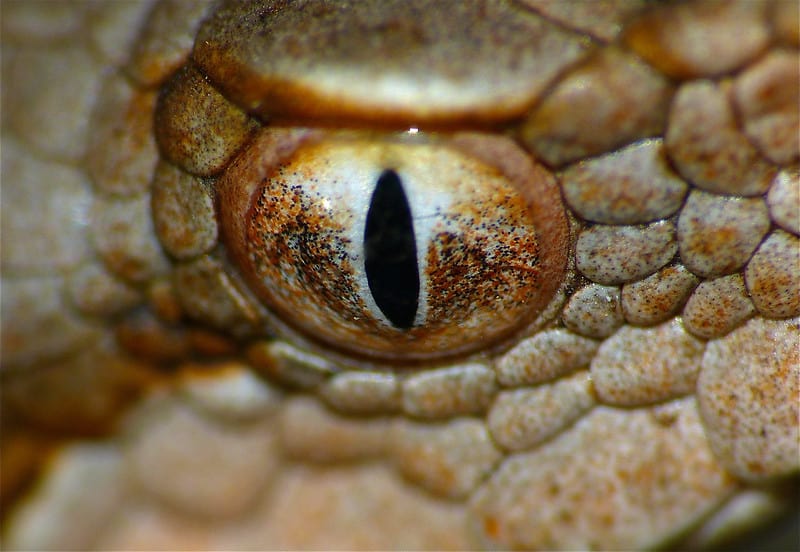
Asp vipers are the resident venomous serpent of France, claiming the lower 80% of the country, with adders controlling the north. They reach 85cm and particularly love hedges on the edges of unkempt meadows.
Unlike the adder, with their evil red eyes, asp vipers are more complex. They’re largely yellow and orange, yet with a burnt look similar to a cheese pizza left in the oven for too long. There’s also random dots of black like sprinkles of pepper, and Styrofoam white on the borders of the pupil.
If you got this close to an asp viper in real life, you’d be a dead man, unless you were incredibly lucky and received a dry bite. Fortunately, technology has made many things possible. There’s iPhones and GPS and smartwatches, but also extreme close ups of snake eyes.
Asp vipers bite an estimated 300 French people per year. The initial symptoms include swelling and painful blistering, followed by vomiting, abdominal pain and falling blood pressure. A few deaths have occurred, such as a 45 year old man in 2014. Like most vipers, their pupils are mere vertical slits.
| 2 | Usambara eyelash viper |
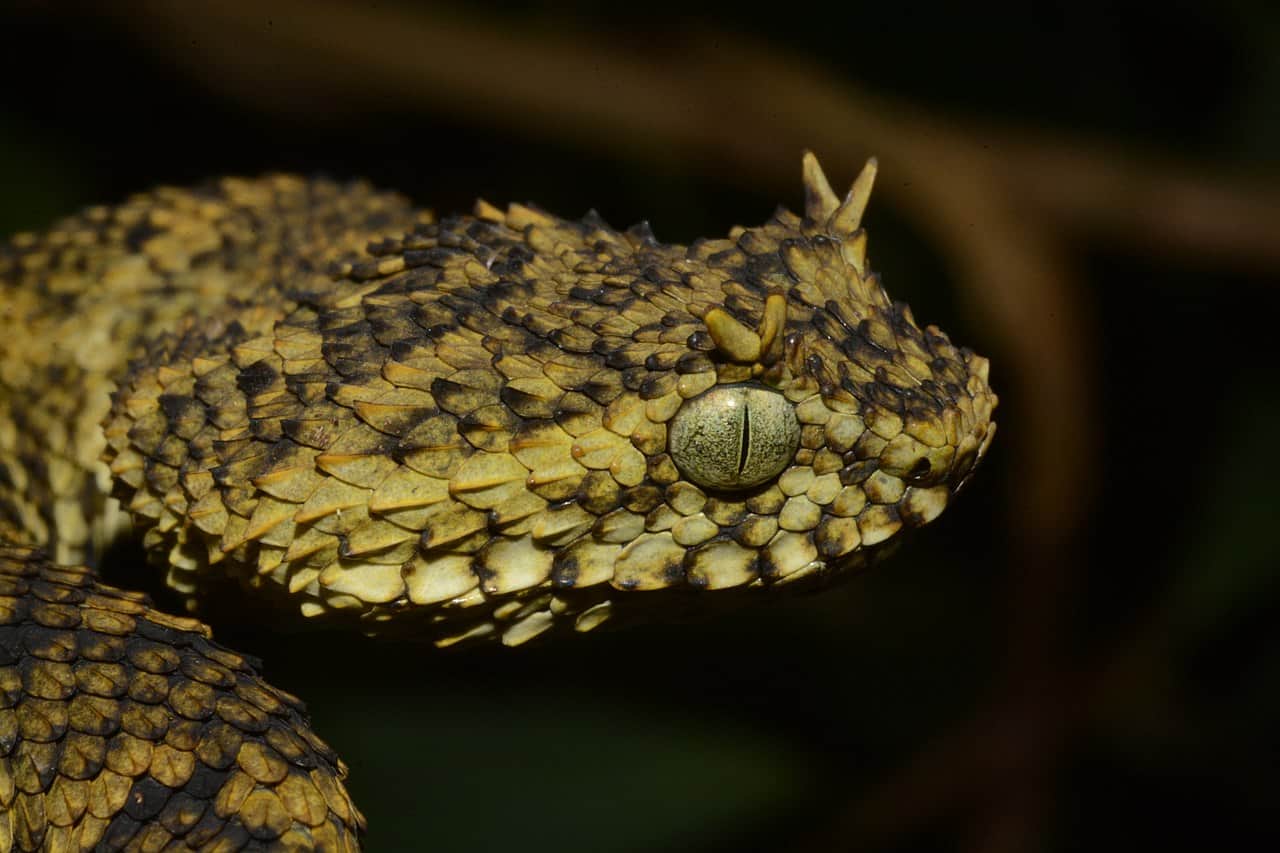
A 50cm snake of Tanzania, with a moderately dangerous venom. Atheris is a family of 17 vipers found across Africa in various enclaves and empires. The thing that unites them is 1) sharply keeled scales, in some cases approaching pineapple territory, and 2) immensely detailed eyes with vertical slits for pupils.
The Usambara eyelash viper (Atheris ceratophora) has vivid black and yellow scales, and a green eye dotted with black. Usambara eyelash vipers live in bushes and on low tree branches, where they rely on ambush tactics. Their eyes are particularly large, and there’s little doubt that the photographer who took the image above was spotted.
This species has been isolated in the Usambara mountains for millions of years, alongside a host of rare creatures such as Usambara robin-chats and Usambara two-horned chameleons. This mountain range lies in northeast Tanzania and reaches a maximum height of 2289 metres, at Chambolo peak, amidst constant rain and mist. Usambara eyelash vipers lie hidden in a sweeping sea of neverending forest, where foraging villagers tread but few else. This species is unrelated to the eyelash viper of central America, but receives its name thanks to enlarged, protruding scales above each eye.
| 3 | Spotted dagger-tooth tree snake |
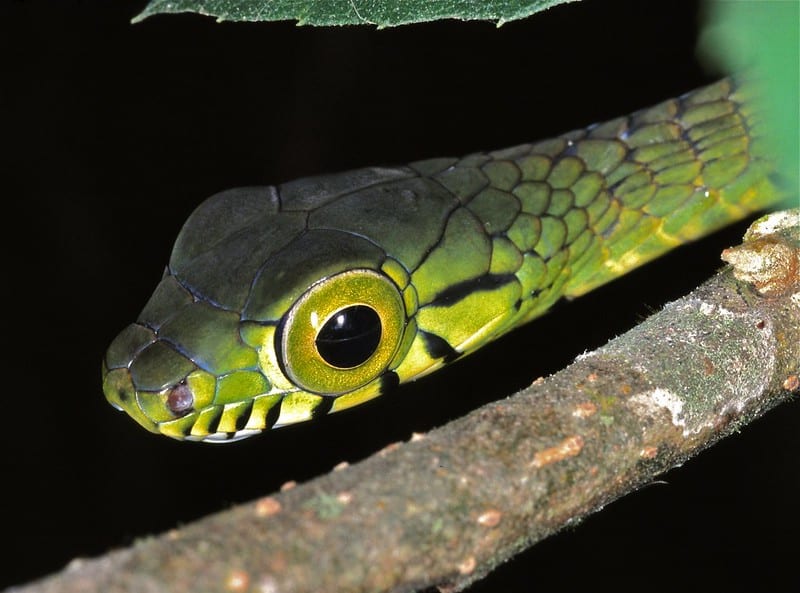
This species lives in central Africa and is diurnal (day-faring). They’re a branch dweller which is moderately venomous, though rear-fanged and forced to angle its jaw awkwardly to inject. A spotted dagger-tooth tree snake would be no match for a cape cobra, but they do beat them in the fabulously detailed eye stakes. This species has particularly bulbous eyes, which stick out of their head on either side from a bird’s eye view. Up close, their irises are detailed with a complex green, not a flat pastel green, but rich and alive like foliage. There’s also a thin white ring bordering their pupil.
The greenness is an essential ingredient in their camouflage, as this snake lives in rainforests at altitudes of 1000 metres or below. Even if they drop down, they’ll be in a 2 foot carpet of rain-soaked bushes. They live in a sea of green, and therefore green is what they must become. Their eyes aren’t exempt (except the black pupils), as even the tiniest detail is important in the barbaric African wilds where just a 0.5% reduction in performance could result in grisly death.
It’s unlikely that you’d get close enough to a spotted dagger-tooth tree snake (Rhamnophis batesii) to see these eyes first hand, as you’d have to battle through miles of rainforest first. This species is also incredible for glowing blue patches on their bodies. Spotted dagger tooth tree snakes inflate their throats when threatened, revealing these blue scales below, which is supposed to be terrifying for some reason (maybe it works on birds).
| 4 | Emerald tree boa |
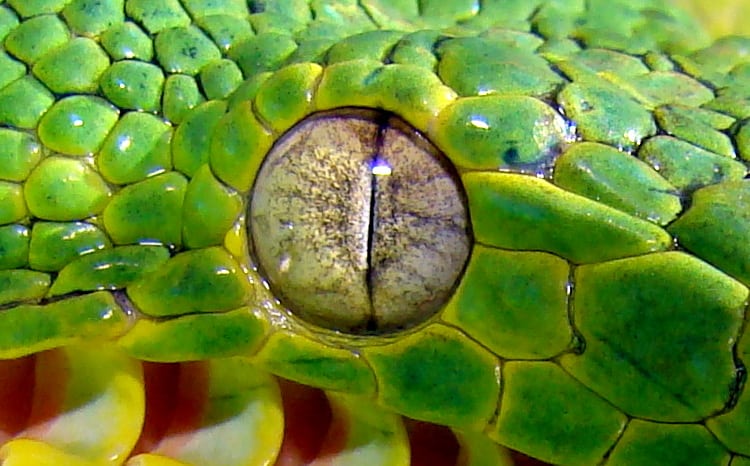
Once upon a time, the emerald tree boa was a normal snake. One fateful day, it decided to slither into the jungle for refuge, and had no idea of the process it had just kickstarted.
Ove millions of years, they ascended to the branches, and then its boa body began to absorb the essence of the rainforest itself. The emerald tree boa slowly became a bright sea of green, broken only by white markings. Its head was green, its body was green and eventually, even its eyes turned the shade of a juicy piece of jungle foliage. Emerald tree boas inhabit Brazil and Paraguay and can reach 2 metres. They’re the far greener, more rainforest-dwelling cousin of the Amazon tree boa (despite the name).
The emerald tree boa is an extreme ambush hunter which goes days without moving. It requires sensitive, bulbous eyes to scan the forest floor and pick up the slightest flicker of movement. A bush could contain a rat, while a lizard could be blending into a branch’s bark. The emerald tree boa must be ready to spring into pounce mode at a moment’s notice, should these creatures stray close enough. All-seeing, all-knowing eyes are an important piece of this puzzle.
| 5 | White-spotted cat snake |
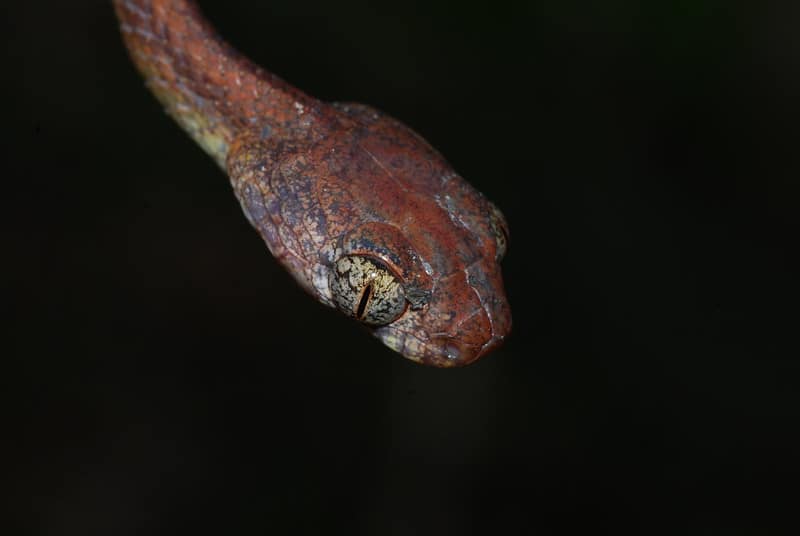
White-spotted catsnakes are one of the more memorable of the Boiga catsnake family (which has 38 members). They’re a near exclusive branch dweller which reaches 2.1 metres, and have extremely juicy orange/black patterns, overlaid with occasional white spots. These colours extend to their eyes with little break, with the signature “cat-eyed” vertical pupil. This species has such colourful eyes that it’s incredible they can see out of them. There’s blue-grey and brown, and subtle yellow tinges on the borders of each. If a human visited hospital with eyes like this, the eye drop bill would be staggering.
The logical explanation is that spotted catsnake eyes are so large that they could be exposed if they’re not camouflaged. But it could be a random glitch – maybe the genes which controlled their body patterns also controlled the eyes. Sometimes nature is random, less structured than people assume.
Boiga drapiezii lives in southern Thailand, peninsular Malaysia, Singapore, and parts of Indonesia. They’re venomous, but rear-fanged, and must chew their victim repeatedly to make any headway. White spotted catsnakes require trees to survive and are particularly common in lowland rainforest, below 1100 metres in altitude.
| 6 | Cloudy snail-eating snake |
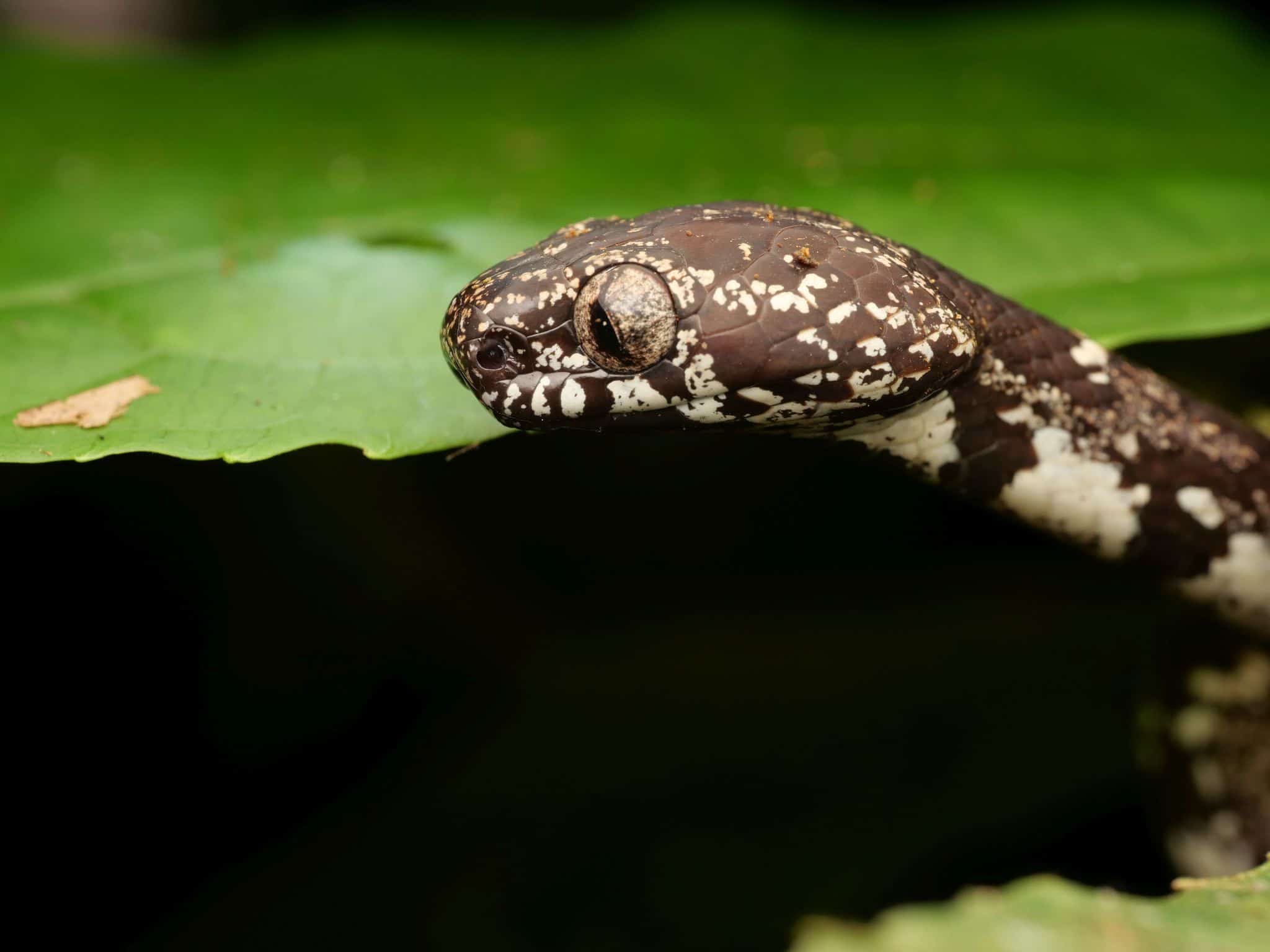
The Sibon snail eating family of South America isn’t particularly powerful. They’re thin-bodied, have no venom, and in a battle with an anaconda, they would probably be swallowed whole. Yet they do boast two special features. The first is sucking a snail directly out of its shell. The second is some of the most fabulously detailed eyes in the snake kingdom.
Virtually all Sibon members have amazing eyes and the cloudy snail eater (Sibon nebulatus) is no exception. This species lives in southern Mexico and central American forests. Like its kin, snails are its main meal, and it spends its life on branches searching for them, usually 1-3 metres above ground.
It’s possible that their eyes provide super-enhanced snail homing vision, but the real reason is more practical. Cloudy snail eaters might be small, but they look huge to their snail prey. Their bulging eyes look particularly huge, so it’s important that they blend into the jungle as much as possible. That means every subtle detail of moss, lichen and leafy debris. That said, snails are incredibly slow and might not be able to escape easily regardless. It’s possible that Sibon nebulatus evolved huge eyes to spot snails, but then became more visible to birds, and only then evolved fabulously detailed colours.
| 7 | Timber rattlesnake |
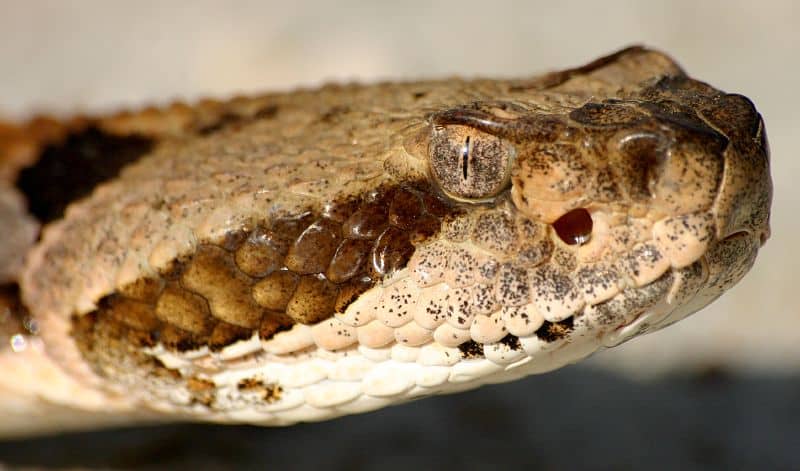
They are very few people who have approached close enough to see a timber rattlesnake’s eyes in detail (still living anyway). Their venom causes haemorrhaging and tears through living skin cells, while their menacing facial expressions have been terrifying Americans since the 1600s.
Technically, this isn’t the timber rattlesnake’s fault. Their brutal appearance is simply an evolutionary tactic designed to scare off predators, and not proof that they’re itching to bite every passing dog walker. Timber rattlesnakes can’t help the way they look. Thanks to the invention of the camera, however, we now know that timber rattlesnakes have highly detailed eyes. They’re a mixture of parched orange and grey, largely reflecting their habitat, which is spacious woodlands in the eastern US, with a thick coating of leaves. The timber rattlesnake’s eyes are framed by a viciously vertical pupil, which they’d be far less intimidating without.
Timber rattlesnakes have incredible camouflage against a leafy floor, and these eyes only add to it. Their tongue, meanwhile, is an oily black.
| 8 | Common egg-eating snake |
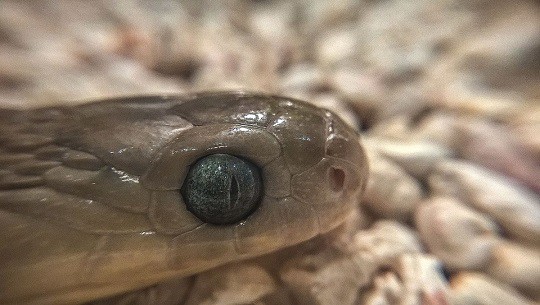
The common egg eater is a species of South Africa, Zimbabwe and many more. They’re non-venomous, and reach 120cm in length. Eggs are their main sustenance, and to acquire them, they generally live in areas with trees – never rainforests, but woodlands, sparser forests, and tangled tree clumps next to savannahs.
Big eyes are another of their adaptive features, which are extremely detailed up close. The exact eye colour varies – the one above is blue like surface of a shimmering magical pool, while others are orange and crusty. Common egg eaters have vertical pupils and move by night. Most of their bodies aren’t as richly colourful – they’re mainly beige interspersed with brown blotches.
Among snakes, the Dasypeltis family are renowned for being able to find eggs effortlessly, as though they’ve installed a homing beacon in them. Who knows what their huge, detailed eyes have to do with this. It’s possible that they provide “egg vision” – like a version of infrared where the only thing that appears in colour are eggs. Dasypeltis scabra can find eggs in a tree without ever having visited it before. The less fun possibility is that they track massive accumulations of scent molecules in nests, as mother birds spend so much time in them.
| 9 | Jararaca |
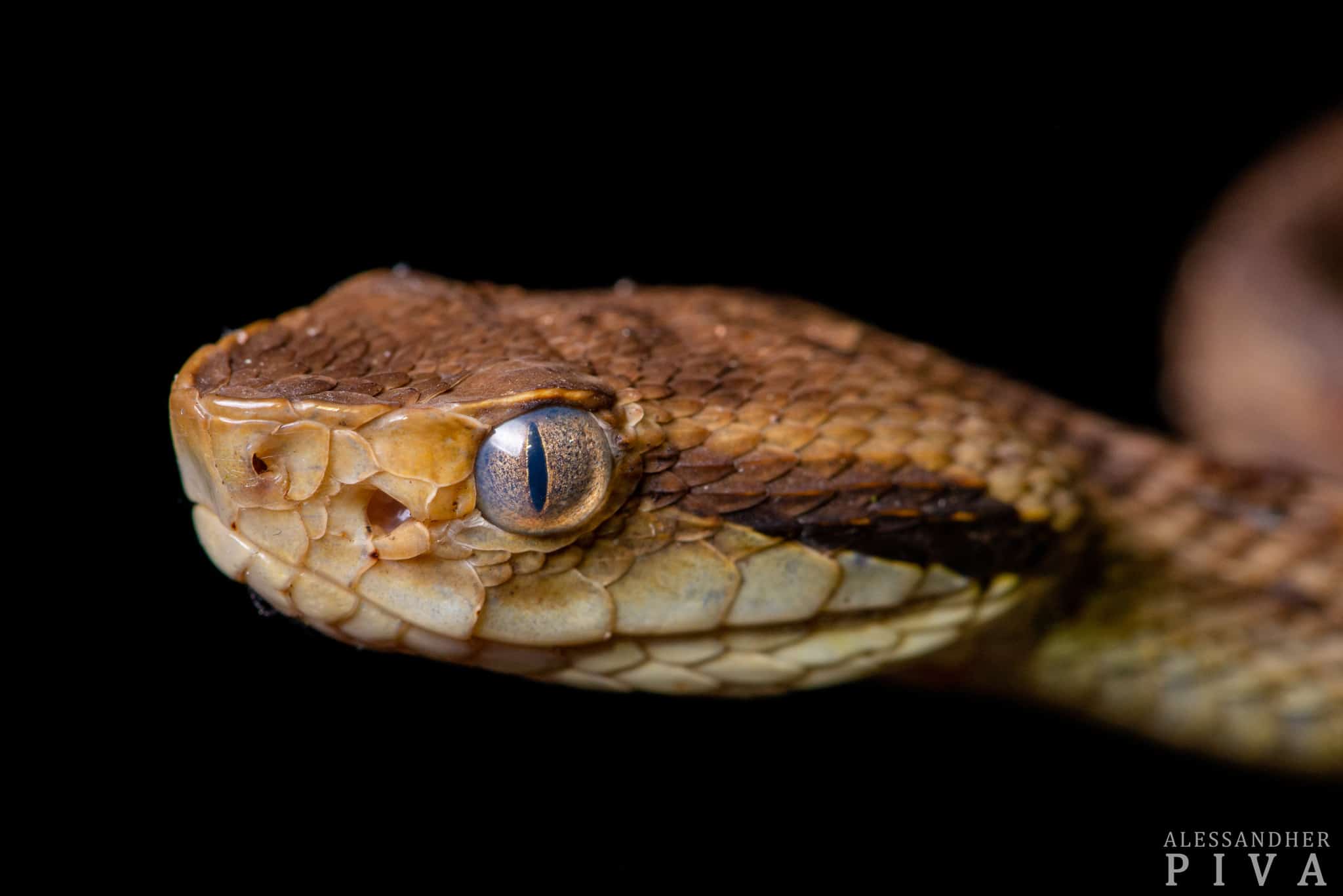
The jararaca is found slithering around the Atlantic forests of Brazil, including near Sao Paulo. They also spill into Paraguay. They’re a snake of variable colours: usually pale grey with dark brown stripes, but sometimes with yellow or green tinges. Their eyes vary, but are always fabulously detailed.
At a distance, the jararaca’s eyes look basic and uninteresting, but up close they gain many subtle details, like hints of sea blue. Their pupils are vertical, as this is mainly a nocturnal snake (there’s a moderate correlation). Uses for a jararaca’s eyes include spotting their mainly mammal prey, and the looming mass of a human drawing near.
This species is extremely dangerous, but doesn’t default to attack, like a madman. One alternative move is to shake their tail furiously against a leafbed, to make a loud racket and scare people away. Their eyes might be richly detailed, but they’re not trying to mesmerise you and draw you in. They just want to go about their jararaca business peacefully. Nevertheless, the best way to view a jararaca’s eyes is through a camera and not by nuzzling your nose up to one.
| 10 | Collared catsnake |
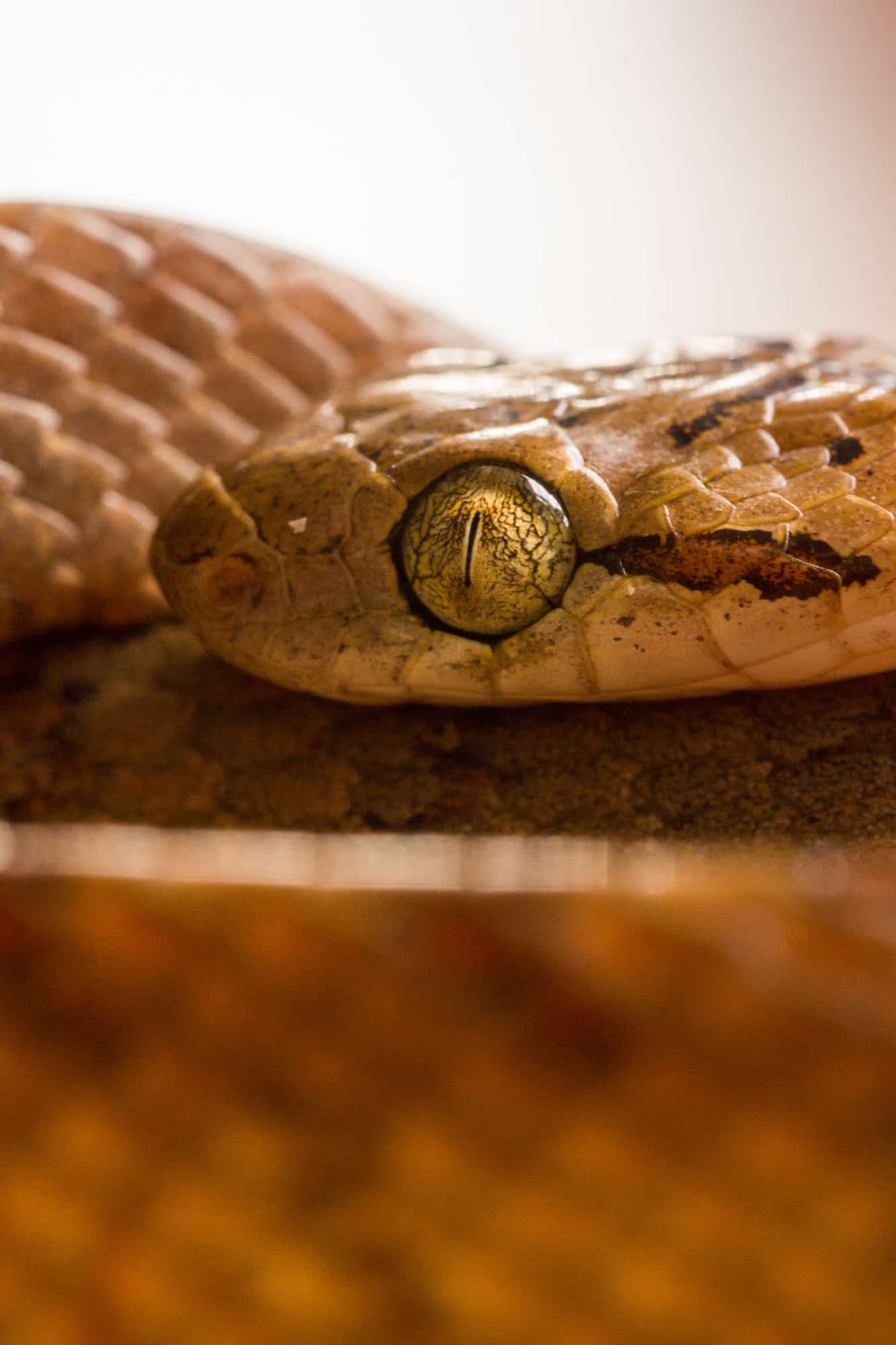
One of southwest India’s signature catsnakes, this species reaches 1.4 meters and has a mild temperament. A yellow body overlaid with orange stripes are their calling cards, but up close, their eyes are spectacular too. The yellow of their body is maintained, but with black cracks and in more sharply contrasting detail. Their pupils are sharply vertical, like all catsnakes.
With these eyes they can spot their favourite prey, the garden lizard, and flee from oncoming photographers, who never realise that the snake was there. Collared catsnakes are tree dwellers, and while they possess a mild venom, no confirmed human deaths are on record.
Though snakes generally have weak eyesight, the vast majority of species haven’t been researched. We know that blind snakes have regressed to mere black dots that simply distinguish between light and dark. We know that coachwhips have vastly superior vision to most, even diffusing blood into their eyes at critical moments for super focus. Inbetween, there’s a big swathe of mystery, and it’s possible that fabulously detailed eyes correlate positively with vision. There’s also a strong tendency for snakes which live on branch perches to have large eyes, including the Boiga catsnake family. The reason is the need to scan the ground for prey. They have more dimensions to view – up, around, and below.
